Holuhraun eruption update – Iceland’s largest lava field since the Laki eruption in 1783-84
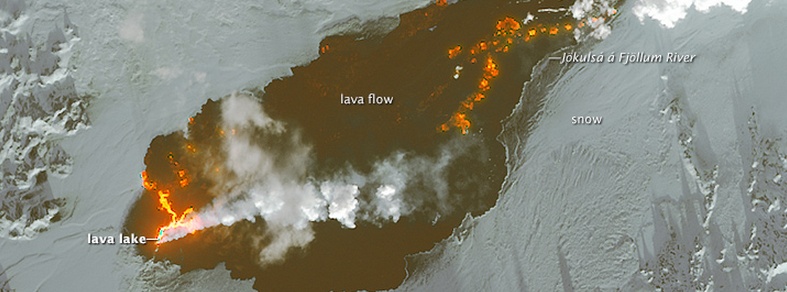
Iceland's subglacial stratovolcano Bardarbunga, located in NW Vatnajökull ice cap, erupted on August 29, 2014 after a sharp increase in seismic activity which started at 03:00 UTC on August 16, 2014.
Today, almost 5 months since the eruption started, seismic activity is still strong, the rate of the subsidence of the Bardarbunga caldera is still significant and the lava field in its Holuhraun eruption fissure (also known as Nornahraun, meaning "Witches lava") now covers more than 84 km2.
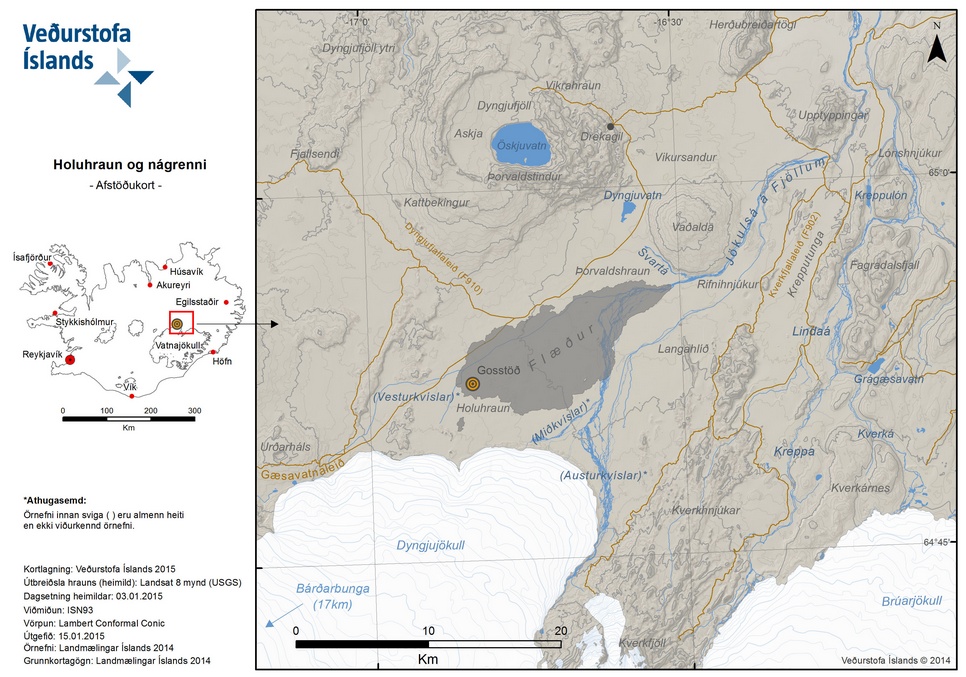
Location map of the Holuhraun eruption site north of Bardarbunga

Video compilation by Jiri VonDrak
Holuhraun is Iceland’s largest basaltic lava flow since the Laki eruption in 1783 – 84, an event which lasted 8 months and resulted in famine which killed about 20 percent of the island’s population. Haze from that eruption was reported from Iceland to Syria. In Iceland, it lead to the loss of most of the island's livestock by eating fluorine contaminated grass and crop failure caused by acid rain.
The climatic effects of the Laki eruption were impressive, Oregon State University writes. "In the eastern United States, the winter average temperature was 4.8 degrees C below the 225 year average. The estimate for the temperature decrease of the entire Northern Hemisphere is about 1 degree C. The Laki eruption illustrates that low energy, large volume, long duration basaltic eruptions can have climatic impacts greater than large volume explosive silica-rich eruptions."
(For more information on local and global impacts of the 1783 – 84 Laki eruption read this article by Erik Klemetti.)
Holuhraun is probably the third largest lava field on Earth over that period, Icelandic Met Office (IMO) said.
Additionally, gas release from a volcanic eruption has had an impact all over Iceland for the first time in 150 years. The reason is the size and the long duration of the Holuhraun eruption.
"Even so, the map below where Nornahraun [Holuhraun] has been inserted between huge lava tongues from Laki, shows first and foremost the enormity of the volcanic events in the 18th and 10th centuries," IMO explains.
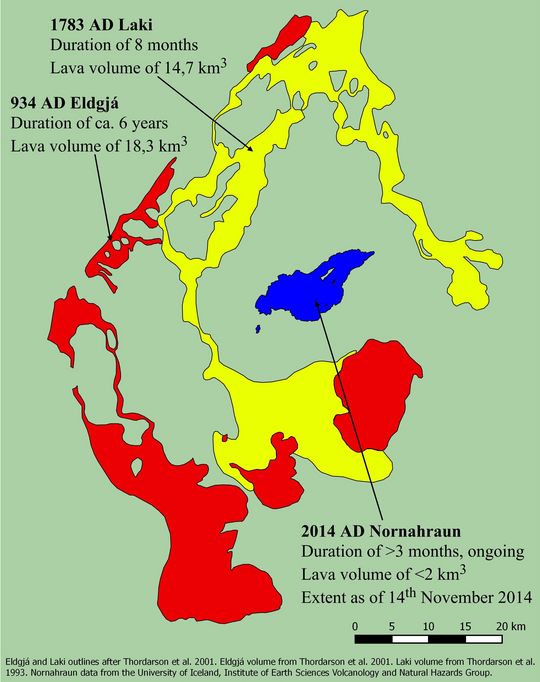

Comparing the area covered by three volcanic eruptions in Iceland: Eldgjá in 934, Laki/Skaftáreldar in 1783-1784 and Nornahraun (Holuhraun) November 14, 2014. References: Eldgjá and Laki outlines and Eldgjá volume from Thordarson et al. 2001. Volume of Laki from Thordarson et al. 1993. Nornahraun data from the University of Iceland, Institute of Earth Sciences' Volcanology and Natural Hazards Group. Specialist: William Moreland.
Preliminary analysis of radar measurements taken during an overflight on December 30, 2014 showed that the lava is on average 10 m thick in the E part, 12 m thick at the center, and about 14 m in the W part. The maximum thickness, near the craters, was about 40 m at the E margin of the lava lake. A preliminary estimate for the volume of the lava was 1.1 cubic kilometers, which is enough for the eruption to be considered a flood basalt.
Volume of Holuhraun's lava flow, over the last few weeks, is estimated to be between 50 – 70 cubic meters per second.
High values of sulfuric dioxide are still being recorded. Around 1800 µg/m3 SO2 were recorded on January 16 in Hofn in Hornarfjordur and around 1750 µg/m3 in Reykjahlid on January 18.
The Scientific Advisory Board of the Icelandic Civil Protection said today that three scenarios are considered most likely:
- The eruption in Holuhraun continues until the subsidence of the Bardarbunga caldera stops. The eruption can still go on for many months.
- The volcanic fissure may lengthen southwards under Dyngjujokull, resulting in a jokulhlaup [glacial outburst flood] and an ash producing eruption. It is also possible that eruptive fissures could develop in another location under the glacier. If such an eruption would be prolonged it could eventually produce a lava flow.
- Volcanic eruption in the Bardarbunga caldera. Such an eruption would melt large quantities of ice, leading to a major jokulhlaup, accompanied by ash fall.
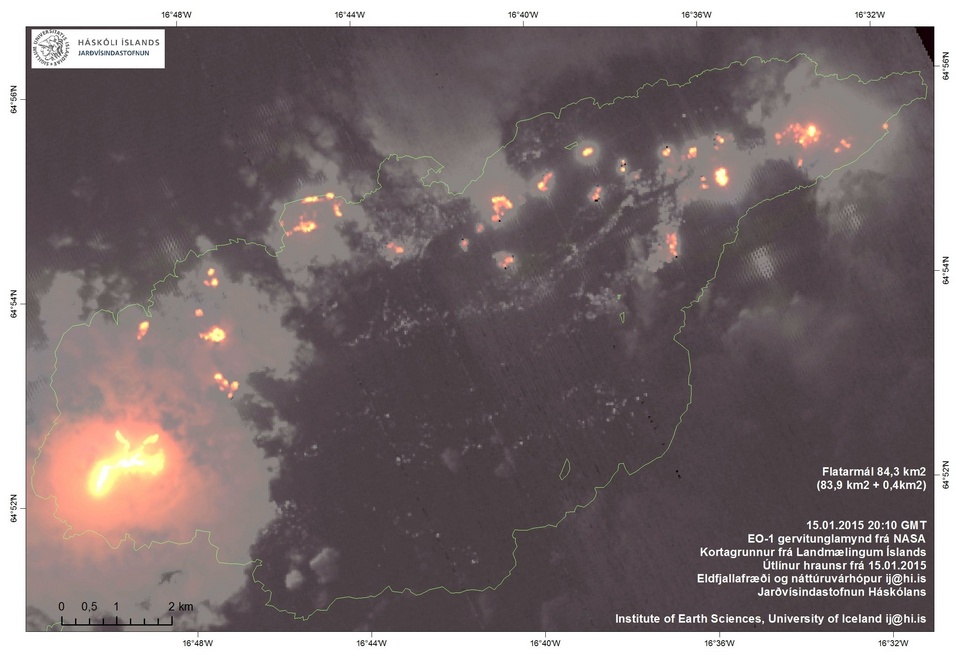

EO-1 satellite image from NASA taken January 15, 2015 shows the lava well. The field was 84,3 km² (83,9 km² + 0,4 km²). Image credit: NASA / Institute of Earth Sciences.
While Holuhraun continues to spew copious amounts of lava and sulfur dioxide, some observations suggest the eruption may be slowing down, NASA's Earth Observatory said.
Icelandic scientists have shown that the subsidence (sinking) of the caldera has declined from 80 centimeters (31 inches) to 25 centimeters per day – a sign that less magma is moving toward the surface. Satellite observations of heat flux show a decline from more than 20 gigawatts in early September 2014 to fewer than 5 gigawatts by the end of November 2014.
In addition, magnitude 5 or higher earthquakes that used to occur daily are now far less frequent (only seven M5+ quakes were registered during December 2014 and only one from December 30, 2014 – January 20, 2015 – M5.1 on January 8).
“This doesn’t mean that the eruption will stop soon. Like the weakening spray from an aerosol can, the eruption rate declines exponentially. The lower the flow, the more slowly it declines,” Edinburgh University volcanologist John Stevenson explained.
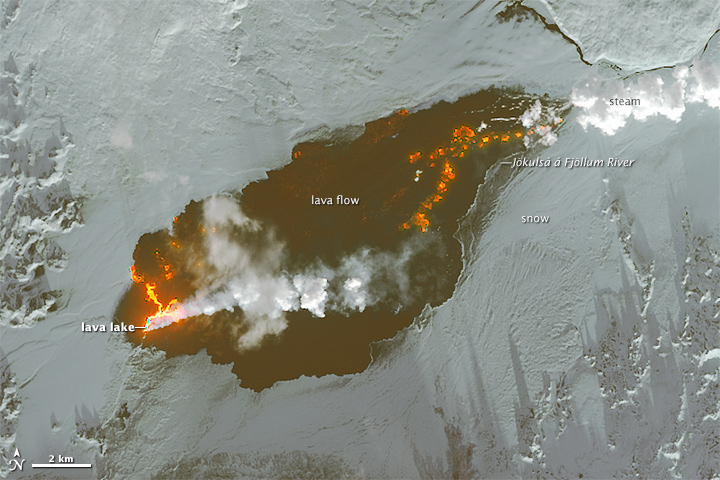

Holuhraun's lava field on January 3, 2015. The false-color images combine shortwave infrared, near infrared, and red light (OLI bands 6-5-4). The plume of steam and sulfur dioxide appears white. Newly-formed basaltic rock is black. Fresh lava is bright orange. A lava lake is visible on the western part of the lava field, and steam rises from the eastern margin where the lava meets the Jökulsá á Fjöllum river. Image credit: USGS / Landsat 8 – OLI
Featured image credit: USGS / Landsat 8 – OLI

Commenting rules and guidelines
We value the thoughts and opinions of our readers and welcome healthy discussions on our website. In order to maintain a respectful and positive community, we ask that all commenters follow these rules:
We reserve the right to remove any comments that violate these rules. By commenting on our website, you agree to abide by these guidelines. Thank you for helping to create a positive and welcoming environment for all.